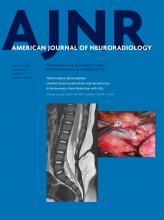Abstract
BACKGROUND AND PURPOSE: Pharmacokinetic parameters from dynamic contrast-enhanced MR imaging have proved useful for differentiating brain tumor grades in adults. In this study, we retrospectively reviewed dynamic contrast-enhanced perfusion data from children with newly diagnosed brain tumors and analyzed the pharmacokinetic parameters correlating with tumor grade.
MATERIALS AND METHODS: Dynamic contrast-enhanced MR imaging data from 38 patients were analyzed by using commercially available software. Subjects were categorized into 2 groups based on pathologic analyses consisting of low-grade (World Health Organization I and II) and high-grade (World Health Organization III and IV) tumors. Pharmacokinetic parameters were compared between the 2 groups by using linear regression models. For parameters that were statistically distinct between the 2 groups, sensitivity and specificity were also estimated.
RESULTS: Eighteen tumors were classified as low-grade, and 20, as high-grade. Transfer constant from the blood plasma into the extracellular extravascular space (Ktrans), rate constant from extracellular extravascular space back into blood plasma (Kep), and extracellular extravascular volume fraction (Ve) were all significantly correlated with tumor grade; high-grade tumors showed higher Ktrans, higher Kep, and lower Ve. Although all 3 parameters had high specificity (range, 82%–100%), Kep had the highest specificity for both grades. Optimal sensitivity was achieved for Ve, with a combined sensitivity of 76% (compared with 71% for Ktrans and Kep).
CONCLUSIONS: Pharmacokinetic parameters derived from dynamic contrast-enhanced MR imaging can effectively discriminate low- and high-grade pediatric brain tumors.
ABBREVIATIONS:
- IAUGC60
- initial area under gadolinium curve at 60 seconds
- DCE
- dynamic contrast-enhanced
- Kep
- rate constant from extracellular extravascular space back into blood plasma
- Ktrans
- transfer constant from the blood plasma into the extracellular extravascular space
- Ve
- extracellular extravascular volume fraction
- Vp
- fractional blood plasma volume
- © 2017 by American Journal of Neuroradiology












